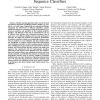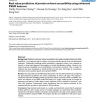294 search results - page 34 / 59 » Predicting the beta-helix fold from protein sequence data |
BIBE
2007
IEEE
13 years 11 months ago
2007
IEEE
Machine learning approaches offer some of the most cost-effective approaches to building predictive models (e.g., classifiers) in a broad range of applications in computational bio...
ALMOB
2006
13 years 7 months ago
2006
Background: An important challenge in eukaryotic gene prediction is accurate identification of alternatively spliced exons. Functional transcripts can go undetected in gene expres...
BIOINFORMATICS
2011
12 years 11 months ago
2011
Summary: We developed a Python package, ProDy, for structurebased analysis of protein dynamics. ProDy allows for quantitative characterization of structural variations in heteroge...
BMCBI
2008
13 years 7 months ago
2008
Background: Prediction of protein solvent accessibility, also called accessible surface area (ASA) prediction, is an important step for tertiary structure prediction directly from...
ICPPW
2009
IEEE
13 years 5 months ago
2009
IEEE
Identifying peptides, which are short polymeric chains of amino acid residues in a protein sequence, is of fundamental importance in systems biology research. The most popular appr...


